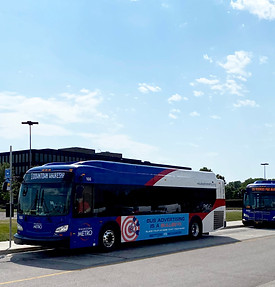
FUNDING THE PLAN
The financial analysis identified a significant funding gap between the Region’s expected revenues and the investment needed to implement the VISION 2050 transportation system. Many factors contribute to this gap, but some of the most significant are the lack of a dedicated funding source for transit, the State “gas tax” (its largest source of transportation revenue) not keeping up with inflation, and statutory restrictions on the funding the Region already receives.
Without additional revenue, the VISION 2050 transportation system will not be possible. This will affect everyone in the Region but traditionally underserved groups such as people of color, people with disabilities, and low-income people are expected to be impacted most due to anticipated declines in transit service. Addressing the Region’s transportation funding gap will require action by State elected officials and may also need support from federal or local elected officials. The financial analysis maintains a list of potential revenue sources to facilitate the discussion on how the Region and State could fill the gap, stop the decline in transit service, and implement VISION 2050.
THE TRANSPORTATON FUNDING GAP
VISION 2050 identified a funding gap between the expected average annual revenues available and the expected average annual investment needed to implement VISION 2050’s public transit and arterial streets and highways elements. Despite increased shared State revenue and sales tax increases for the City of Milwaukee and Milwaukee County in 2023, significant funding shortages remain. Specifically, the analysis updated in 2024 identified a $234 million annual funding gap for public transit and a $558 million annual funding gap for the arterial street and highway portions of the plan. No gap is anticipated for the bicycle and pedestrian element of VISION 2050.

CONSEQUENCES OF INSUFFICIENT TRANSPORTATION FUNDING
The Commission is federally required to “fiscally constrain” VISION 2050’s transportation component. In other words, the plan must show only the transportation projects the Region can fund using reasonably expected revenues from federal, State, and local sources through 2050. The result of this constraint is called the Fiscally Constrained Transportation System (FCTS). The FCTS is neither a plan nor a desired future state for the Region and is expected to result in negative consequences for all modes of travel.
PUBLIC TRANSIT
Under the fiscally constrained transportation system, the funding gap for public transit is expected to result in a 30% reduction in transit services levels by 2050—rather than a doubling of service as recommended under VISION 2050. Consequences of this reduction in service include:
-
Reduced access to jobs, healthcare, education, and other daily mobility needs, particularly for households without access to a car, which is more likely to affect people of color, low-income residents, people with disabilities, and seniors
-
Smaller labor force available to employers and reduced ability to compete with other metro areas to attract workers and employers
-
Reduced traffic carrying capacity in the Region's heavily traveled corridors
-
Reduced ability to develop compact, walkable neighborhoods and transit-oriented development and redevelopment
-
Compromised air quality
STREETS AND HIGHWAYS
Under the fiscally constrained transportation system, the funding gap for the streets and highways portion of the plan is expected to result in fewer roads being reconstructed, widened, or newly built. Many of the roadways recommended to be reconstructed by 2050 would instead be rehabilitated, extending the overall life of the existing roadways but likely reducing pavement quality. Consequences of postponing freeway reconstruction and not adding capacity on highly congested segments include:
-
Costly emergency repairs and inefficient pavement maintenance
-
Increased traffic congestion and travel delays, along with decreased travel reliability
-
Increased crashes due to traffic congestion, outdated roadway design, and deteriorating roadway conditions


POTENTIAL REVENUE SOURCES TO ADDRESS THE TRANSPORTATION FUNDING GAP

Wheel Tax
An increase in the vehicle registration fee (“wheel tax”) is essentially the only lever available for Wisconsin counties and municipalities to raise transportation funding without a change in State law. A hypothetical increase in this fee has been included in other analyses of transit funding in the Region.
Vehicle-Miles Traveled (VMT) Fee
A mileage-based registration fee moves roadway costs to motorists by charging an annual fee per mile driven. VMT fees have been studied and piloted in many states and are consistent with VISION 2050’s recommendation to price personal vehicle travel at its true cost.
Sales Tax
An increase in the sales tax, the most common source of dedicated transit funding in the country, could dedicate tax proceeds to transit projects. This could be scaled to certain counties in the Region so areas without extensive transit service would not pay for areas with heavily utilized transit.
Gas Tax
The gas tax levies a per-gallon fee on gasoline sold in the State. Wisconsin’s gas tax was once indexed to inflation and fuel consumption. After these requirements were removed, the gas tax has not been adjusted since 2006. Improvements in fuel efficiency continue to reduce the effectiveness of the gas tax.
Tolling
Tolling would require motorists to pay a fee for use of a highway facility. An example of this in practice comes from the Illinois Tollway in the Chicago region. Like VMT fees, tolling would charge motorists based on roadway usage; however, it would also ensure out-of-state motorists pay for their use of the system.
Highway Use Fee
A highway use fee would involve a one-time charge on new vehicle purchases based on a percentage of the manufacturer's suggested retail price (MSRP).

